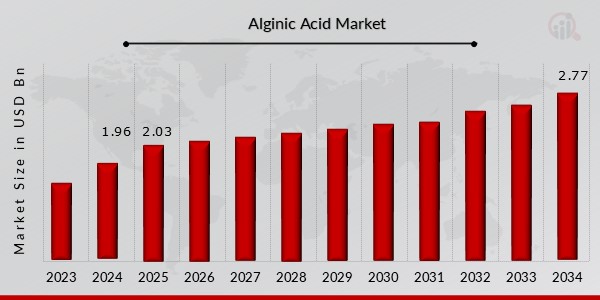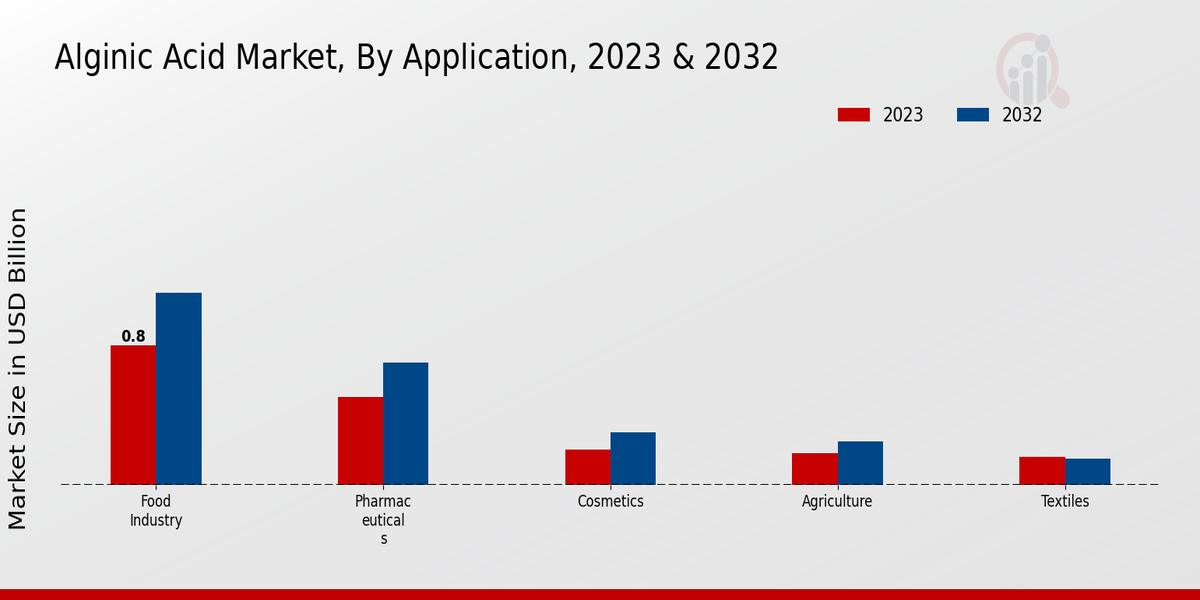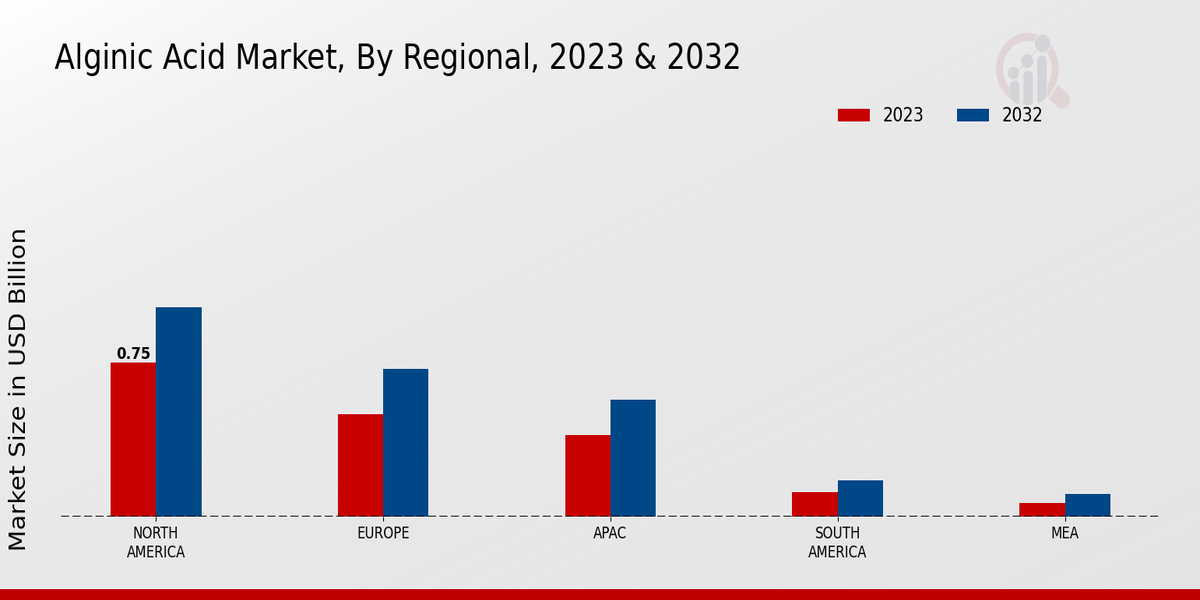Global Alginic Acid Market Overview
The Alginic Acid Market Size was estimated at 1.96 (USD Billion) in 2024. The Alginic Acid Industry is expected to grow from 2.03(USD Billion) in 2025 to 2.77(USD Billion) by 2034. The Alginic Acid Market CAGR (growth rate) is expected to be around 3.5% during the forecast period (2025 - 2034).
Key Alginic Acid Market Trends Highlighted
The alginic acid market is witnessing significant growth driven by the increasing demand for natural thickeners in the food industry. The surge in consumer preference for organic and clean-label products enhances the market appeal, as alginic acid is derived from brown seaweed and is viewed as a healthier alternative to synthetic additives. Additionally, its versatility in applications across pharmaceuticals, cosmetics, and textiles further propels its adoption. The rising trend of plant-based diets and natural ingredients aligns well with the properties of alginic acid, fostering an environment conducive to market expansion. Opportunities to be explored in the alginic acid market include innovations in extraction and purification methods to reduce costs and enhance quality.There is also significant potential in the development of new applications, particularly in the biotechnological and biomedical fields, where alginic acid is being studied for drug delivery systems and tissue engineering. Moreover, emerging markets in Asia-Pacific, where seaweed cultivation is thriving, are poised to offer new avenues for growth. Capitalizing on these opportunities could prove beneficial for stakeholders seeking to enhance their market position. In recent times, there has been a noticeable trend towards sustainability and eco-friendliness among consumers and manufacturers alike. This shift has prompted greater investment in sustainable sourcing practices and environmentally friendly production methods.The alginic acid market is adapting to these changes, with companies prioritizing sustainable practices in their supply chains. Furthermore, research and development efforts are centered on enhancing the functionality of alginic acid, aiming to meet evolving consumer needs and preferences. Overall, the alginic acid market reflects a dynamic interplay of traditional applications and innovative prospects, making it a sector to watch in the coming years.

Source: Primary Research, Secondary Research, MRFR Database and Analyst Review
Alginic Acid Market Drivers
Growing Demand in the Food and Beverage Sector
The increasing demand for natural and health-oriented food products is significantly driving the Alginic Acid Market Industry. Consumers are becoming more health-conscious, leading to a surge in demand for food additives that are perceived as safe and beneficial. Alginic acid, a natural polysaccharide derived from brown seaweed, is recognized for its thickening, gelling, and stabilizing properties, making it an ideal ingredient in various food applications.It is widely used in products such as ice cream, dressings, sauces, and bakery items. As the trend towards clean-label products continues to gain traction, manufacturers are incorporating alginic acid into their formulations to enhance texture and improve shelf-life while meeting consumer preferences for natural ingredients. This shift not only boosts sales within the food and beverage industry but also fosters innovation as companies experiment with alginic acid in new product development.Such advancements are likely to expand the market's potential, as the versatility of alginic acid allows for its use in vegetarian, vegan, and gluten-free products, catering to diverse dietary needs. The focus on healthy eating is expected to shape the future landscape of the Alginic Acid Market Industry significantly.
Rising Application in Pharmaceuticals
The pharmaceutical sector's increasing use of alginic acid as a drug delivery agent and excipient is a prominent driver of the Alginic Acid Market Industry. Alginic acid's ability to form gels and its biocompatibility makes it ideal for encapsulating drugs, providing a controlled release and enhancing bioavailability. This characteristic has led to its adoption in various medical formulations, including tablets and capsules, contributing to the market's growth.As pharmaceutical companies continue to invest in innovative drug delivery systems, the demand for alginic acid as an essential raw material is projected to rise significantly.
Expansion in the Cosmetic Industry
The expanding use of alginic acid in cosmetic formulations is another key driver propelling the Alginic Acid Market Industry. With the beauty sector's shift towards natural and organic ingredients, alginic acid has emerged as a favored component due to its moisturizing and skin-soothing properties. It is commonly found in products such as creams, lotions, and masks. The increasing consumer preference for sustainable and environmentally friendly products in the cosmetics space enhances the market potential for alginic acid as brands seek to incorporate effective natural ingredients in their formulations.
Alginic Acid Market Segment Insights
Alginic Acid Market Application Insights
The Alginic Acid Market, primarily driven by its applications across various industries, presents a significant landscape for growth and innovation. In 2023, the market valuation stands at 1.84 USD Billion, with expectations to reach 2.5 USD Billion by 2032, showcasing a consistent demand for alginic acid. The food industry represents a major part of the market, valued at 0.8 USD Billion in 2023, with projections for growth to 1.1 USD Billion by 2032. This substantial size can be attributed to the increasing consumer preference for natural food additives, providing functionality such as thickening, gelling, and stabilizing agents in food products.The pharmaceutical sector follows closely, valued at 0.5 USD Billion in 2023 and expected to rise to 0.7 USD Billion by 2032. Its importance lies in the utilization of alginic acid in drug formulations and as a viscosity modifier, enhancing bioavailability and controlled release formats. In the cosmetics industry, alginic acid is valued at 0.2 USD Billion in 2023, with a growth trajectory to 0.3 USD Billion by 2032, reflecting the rising trend toward natural and biodegradable ingredients in skincare and beauty products. The agriculture segment, valued at 0.18 USD Billion in 2023, is anticipated to increase to 0.25 USD Billion by 2032, where alginic acid's role as a soil conditioner and plant growth enhancer is gaining traction among eco-conscious farmers.The textiles industry, however, holds the smallest share, valued at 0.16 USD Billion in 2023, which is expected to slightly decrease to 0.15 USD Billion in 2032, signaling a challenging market position as synthetic alternatives dominate this space. Overall, trends show a collective growth in these sectors, driven by increasing consumer awareness and demand for sustainable, natural products. The Alginic Acid Market data reflects an evolving landscape where applications are expanding, creating opportunities for suppliers and manufacturers to innovate further, thereby capitalizing on the market growth in key segments.

Source: Primary Research, Secondary Research, MRFR Database and Analyst Review
Alginic Acid Market Type Insights
The Alginic Acid Market, valued at 1.84 USD Billion in 2023, is characterized by a diverse array of types, each serving unique applications across various industries. Sodium Alginate dominates the market, primarily utilized in food, pharmaceuticals, and cosmetics due to its excellent thickening and gelling properties, making it a preferred choice among manufacturers. Calcium Alginate is significant for its biocompatibility, widely used in medical and biomedical applications, showcasing the market's versatility. Meanwhile, Potassium Alginate plays a crucial role in the food sector for its ability to stabilize emulsions, while Ammonium Alginate is often utilized in textile and paper industries, emphasizing the material's functionality across different domains.The segmentation of the Alginic Acid Market illustrates the demand dynamics and diverse applications driving market growth, presenting opportunities for innovation and expansion in sectors like food processing and pharmaceuticals. As the market evolves, these types contribute to shaping the Alginic Acid Market data and statistics, highlighting distinct preferences and trends that influence overall market trajectory.
Alginic Acid Market Form Insights
The Alginic Acid Market, valued at approximately 1.84 billion USD in 2023, has showcased steady growth within the Form segment, which includes Powder, Granules, and Liquid formats. Each format caters to diverse applications in food, pharmaceuticals, and cosmetics, contributing significantly to the overall market dynamics. Powder primarily serves in the dietary and food industries, where it is valued for its thickening and gelling properties, while Granules are widely used in the production of various industrial applications due to their ease of use and consistent flow.Liquid forms are essential in the pharmaceutical sector for their convenience and effectiveness in topical applications. The segmentation of the Alginic Acid Market highlights a balanced demand across these forms, with particular growth observed in the liquid format driven by the rising demand for natural and organic products. Moreover, the market growth is supported by increasing awareness of alginic acid's health benefits, although it faces challenges such as stringent regulatory requirements and competition from synthetic alternatives.Overall, comprehensive Alginic Acid Market data reflects a vibrant and evolving landscape driven by innovation and shifting consumer preferences.
Alginic Acid Market End Use Insights
The Alginic Acid Market is expected to reach a valuation of 1.84 billion USD in 2023, with its segmentation by End Use playing a crucial role in market dynamics. Among the various applications, the Food Additive segment is particularly important due to its role in enhancing food quality and extending shelf life, which contributes to its significant market share. The Stabilizer function of alginic acid maintains the consistency and stability of food products, making it vital in processed foods. Additionally, the Thickening Agent application is instrumental in the culinary industry, providing desirable textures in various food items.The growing demand for natural food additives and the rising consumer preference for clean-label products are driving market dynamics in these areas. The Alginic Acid Market statistics highlight a steady growth trend, presenting opportunities for companies to innovate and enhance product offerings within these key end-use applications. The increasing focus on health and wellness further supports the significance of these functions, positioning them as essential components in the food industry and driving the overall market growth.
Alginic Acid Market Regional Insights
The Alginic Acid Market revenue is expected to experience steady growth across various regional markets. In 2023, North America will lead the market with a valuation of 0.75 USD Billion, expected to rise to 1.02 USD Billion by 2032, showcasing its majority holding in consumption driven by the food and pharmaceutical industries. Europe follows, valued at 0.5 USD Billion in 2023 and projected to reach 0.72 USD Billion in 2032, reflecting significant demand for alginic acid in industrial applications. The APAC region, valued at 0.4 USD Billion in 2023, holds a strong position as the market grows at a rapid pace, expected to see an increase to 0.57 USD Billion by 2032, driven primarily by rising consumer awareness and health trends.South America and the MEA regions, while smaller players, display growth opportunities, with valuations of 0.12 USD Billion and 0.07 USD Billion in 2023, rising to 0.18 USD Billion and 0.11 USD Billion, respectively, by 2032. The overall Alginic Acid Market statistics highlight the importance of North America and Europe due to their larger consumer bases, while APAC presents a growing potential driven by increasing market growth and research developments within the region.

Source: Primary Research, Secondary Research, MRFR Database and Analyst Review
Alginic Acid Market Key Players and Competitive Insights
The Alginic Acid Market has witnessed a surge in interest and innovation due to the versatility and applicability of alginic acid in various industries. This natural polysaccharide derived from brown seaweed is primarily utilized in food, pharmaceuticals, cosmetics, and biotechnology, establishing itself as a crucial ingredient across these sectors. Key players in the market are continually engaged in enhancing their product offerings and developing sustainable extraction processes to meet the increasing demand for alginic acid. Firm investments in research and development are pivotal as companies strive to maintain their competitive edge, improve efficiency, and address environmental concerns while fulfilling customer requirements. Robust marketing strategies and expanding geographical footprints will also drive competition among major participants in the space.DuPont has successfully carved a significant niche within the Alginic Acid Market through its commitment to innovation and quality. The company's advanced production techniques and emphasis on sustainability have made it a leader in the manufacturing of alginic acid. DuPont's strong research and development capabilities enable it to offer high-quality and diverse alginic acid products tailored to various industry needs. By fostering strategic partnerships and focusing on customer-centric solutions, DuPont has enhanced its market presence and established a reputation for reliability and excellence. The company's extensive experience and authoritative presence within the market provide it with a competitive advantage, helping to ensure its products meet stringent regulatory standards and satisfy customer demands for high-performance materials.Gelymar stands out as an important player in the Alginic Acid Market by leveraging its expertise and robust portfolio of alginate products. The company has a distinct focus on sustainable practices and environmentally friendly production methods, positioning itself favorably in a market that increasingly values sustainability. Gelymar's commitment to research and development allows for continual enhancement of its alginate offerings, catering to a diverse array of applications in the food, pharmaceutical, and cosmetics sectors. Its strategic initiatives to expand market reach via collaborations and acquisitions further bolster its competitiveness. Gelymar's strong emphasis on quality and performance, combined with responsive customer service, reinforces its position as a trusted provider of alginic acid, making it a formidable competitor in the landscape of the Alginic Acid Market.
Key Companies in the Alginic Acid Market Include
- DuPont
- Gelymar
- Acadian Seaplants
- Sambavanam
- FMC Corporation
- Jiangsu NHSQ
- Gonzalez Byass
- Sodium Alginate
- Algaia
- Hangzhou Greenfresh
- Nexira
- Shepherd Chemical Company
- Qingdao Yunzhou
- NMF
- Kraft Foods
Alginic Acid Market Industry Developments
Recent developments in the Alginic Acid Market have been noteworthy, particularly with companies like DuPont, FMC Corporation, and Acadian Seaplants expanding their product lines to cater to diverse applications such as food, pharmaceuticals, and cosmetics. The market has seen a notable increase in demand driven by the food industry’s growing interest in natural food additives and stabilizers. Growth in market valuation for companies such as Gelymar and Sambavanam is indicative of this trend, with rising investments in R&D to improve alginic acid extraction techniques. Additionally, Jiangsu NHSQ and Hangzhou Greenfresh are focusing on enhancing production efficiency and sustainability, which align with environmental standards. Recent mergers and acquisitions have also played a critical role; for instance, strategic alliances among major players like Nexira and Algaia are expected to bolster market penetration. The current economic dynamics, influenced by increasing consumer preference for organic and plant-based ingredients, further emphasize the significance of alginic acid. This collective movement within the market highlights the competitive landscape and the importance of innovation and strategic partnerships among key players, including Shepherd Chemical Company and Kraft Foods.
Alginic Acid Market Segmentation Insights
Alginic Acid Market Application Outlook
- Food Industry
- Pharmaceuticals
- Cosmetics
- Agriculture
- Textiles
Alginic Acid Market Type Outlook
- Sodium Alginate
- Calcium Alginate
- Potassium Alginate
- Ammonium Alginate
Alginic Acid Market Form Outlook
Alginic Acid Market End Use Outlook
- Food Additive
- Stabilizer
- Thickening Agent
Alginic Acid Market Regional Outlook
- North America
- Europe
- South America
- Asia Pacific
- Middle East and Africa
| Report Attribute/Metric |
Details |
| Market Size 2024 |
1.96(USD Billion) |
| Maret Size 2025 |
2.03(USD Billion) |
| Market Size 2034 |
2.77(USD Billion) |
| Compound Annual Growth Rate (CAGR) |
3.5% (2025 - 2034) |
| Report Coverage |
Revenue Forecast, Competitive Landscape, Growth Factors, and Trends |
| Base Year |
2024 |
| Market Forecast Period |
2025 - 2034 |
| Historical Data |
2020 - 2024 |
| Market Forecast Units |
USD Billion |
| Key Companies Profiled |
DuPont, Gelymar, Acadian Seaplants, Sambavanam, FMC Corporation, Jiangsu NHSQ, Gonzalez Byass, Sodium Alginate, Algaia, Hangzhou Greenfresh, Nexira, Shepherd Chemical Company, Qingdao Yunzhou, NMF, Kraft Foods |
| Segments Covered |
Application, Type, Form, End Use, Regional |
| Key Market Opportunities |
Rising demand in the food industry, Growth in pharmaceutical applications, Increasing use in cosmetics products, Expanding bioengineering and biomedical applications, Surging interest in sustainability and natural products |
| Key Market Dynamics |
Growing demand in the food industry, Increasing use in pharmaceuticals, Rising applications in cosmetics, Environmental sustainability concerns, Expanding use in animal feed |
| Countries Covered |
North America, Europe, APAC, South America, MEA |
Frequently Asked Questions (FAQ) :
The Alginic Acid Market is expected to be valued at 2.77 USD Billion by 2034.
The expected CAGR for the Alginic Acid Market from 2025 to 2034 is 3.5%.
North America is projected to have the largest market size in the Alginic Acid Market, estimated at 1.02 USD Billion by 2032.
The Food Industry is expected to hold the largest value in the Alginic Acid Market, projected to be 1.1 USD Billion by 2032.
Key players in the Alginic Acid Market include DuPont, Gelymar, Acadian Seaplants, and FMC Corporation.
The Pharmaceuticals application segment of the Alginic Acid Market is estimated to reach 0.7 USD Billion by 2032.
The Asia-Pacific (APAC) region is anticipated to experience significant growth, with a market value projected at 0.57 USD Billion by 2032.
The market size for the Cosmetics application of Alginic Acid is valued at 0.2 USD Billion in 2023.
By 2032, South America is projected to reach 0.18 USD Billion, and MEA to reach 0.11 USD Billion in the Alginic Acid Market.
The Textiles application of Alginic Acid was valued at 0.16 USD Billion in 2023.
















